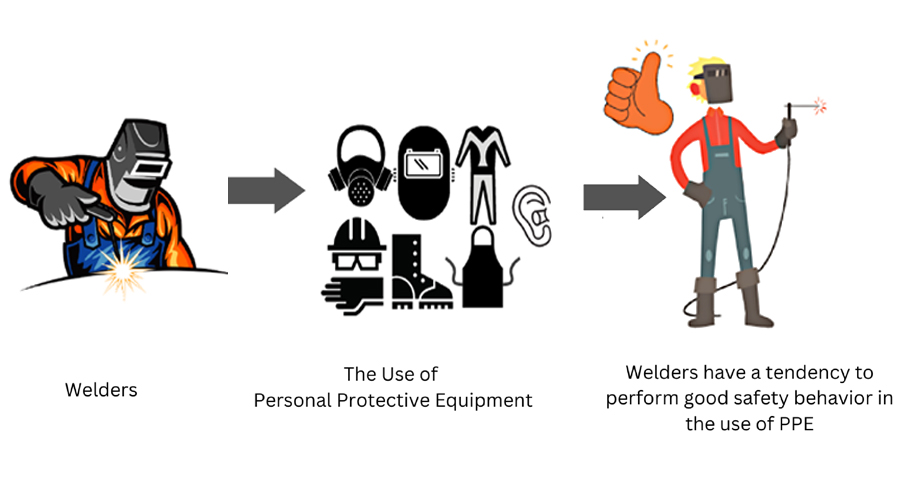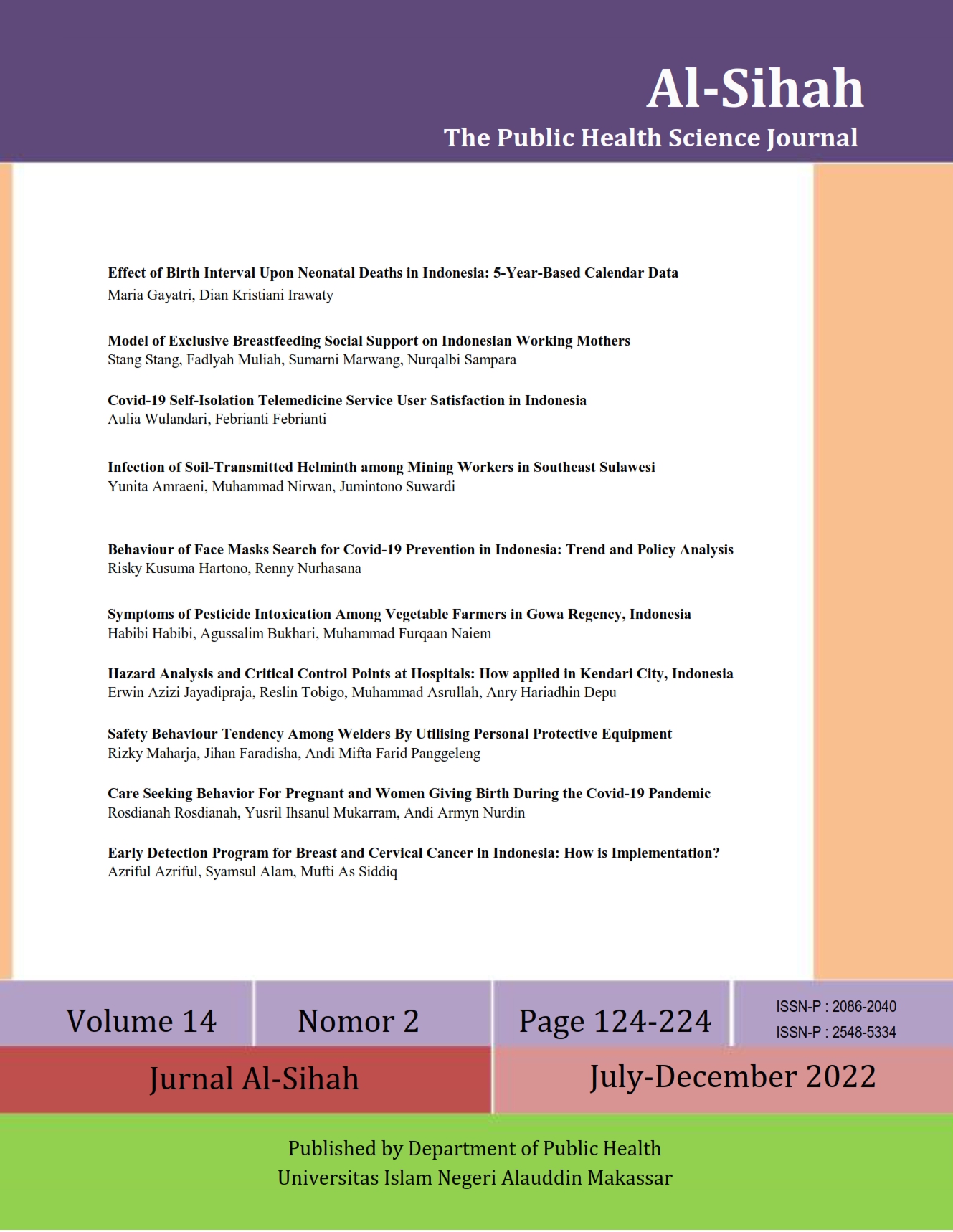Safety Behaviour Tendency Among Welders By Utilising Personal Protective Equipment
Abstract
Welding is one type of work potentially triggering work accidents. It is thus necessary to prevent work accidents in welding to minimize potential hazards and to prevent both work accidents and significant losses by the safety behaviour by using personal protective equipment. This current study aims to analyze the tendency of safety behaviour among welders in using PPE properly. This research was conducted through an analytic observational study using a cross-sectional design. It was carried out on welders at one of the shipbuilding companies in Indonesia. Sampling was chosen using a total population of 58 respondents. All research instruments, questionnaires, and analysis sheets have been tested for validity and reliability. The researchers looked at the Odds Ratio in the Ordinal Regression test to see behaviour tendency. The results suggest that the variables of knowledge, OSH training, and the reward system have a value of OR > 1. the variables of attitude, work readiness, availability of PPE, OSH promotion, and interaction between workers have a value of OR <1. This study found that welders tend to perform good safety behaviour using personal protective equipment based on determinants of behaviour such as knowledge, attitude, work readiness, availability of PPE, the interaction between workers, OSH promotion, OSH training, reward system, and supervision. Nevertheless, based on the OR value, the safety behaviour tendency differs for each behavioural determinant.

Downloads
References
American Federation of State County and Municipal Employees. (2011). Health and Safety Sheet, Welding Hazard.
Asriani, M., Hasyim, H., & Purba, I. (2011). Faktor-faktor yang Berhubungan Dengan Perilaku TIdak Aman (Unsafe Act) di Bagian Pabrik Urea PT Pupuk Sriwidjaja Palembang. Jurnal Ilmu Kesehatan Masyarakat, 2, 103–109. https://ejournal.fkm.unsri.ac.id/index.php/jikm/article/view/68
Ayu, B. F., Tualeka, A. R., & Wahyudiono, Y. D. A. (2018). The analysis of factors which are related to the compliance of welder workers in using workplace personal protective equipment in Pt. pal Indonesia. Indian Journal of Public Health Research & Development, 9(5), 47-52. https://doi.org/10.5958/0976-5506.2018.00410.2
Badan Penyelenggara Jaminan Sosial Ketenagakerjaan. (2019). Angka Kecelakaan kerja Cenderung Meningkat BPJS Ketenagakerjaan Bayar Uang Santunan Rp,1,2 Triliun.
De-las-Heras-Romero, J., Lledo-Alvarez, A. M., Lizaur-Utrilla, A., & Lopez-Prats, F. A. (2017). Quality of life and prognostic factors after intra-articular tibial pilon fracture. Injury, 48(6), 1258-1263. https://doi.org/10.1016/j.injury.2017.03.023
Esu, U., & Ekanem, U. (2021). Awareness and utilization of personal protective equipment among small-scale welders in Cross River State, Nigeria : a descriptive cross-sectional study. Babcock University Medical Journal, 4(1), 1–7. https://doi.org/10.38029/bumj.v4i1.56
Feng, Y., Zhang, S., & Wu, P. (2015). Factors influencing workplace accident costs of building projects. Safety science, 72, 97-104. https://doi.org/10.1016/j.ssci.2014.08.008
Fernández-Muñiz, B., Montes-Peón, J. M., & Vázquez-Ordás, C. J. (2014). Safety leadership, risk management and safety performance in Spanish firms. Safety science, 70, 295-307. https://doi.org/10.1016/j.ssci.2014.07.010
Fuller, C., Besser, S., Savage, J., McAteer, J., Stone, S., & Michie, S. (2014). Application of a theoretical framework for behavior change to hospital workers’ real-time explanations for noncompliance with hand hygiene guidelines. American journal of infection control, 42(2), 106-110. https://doi.org/10.1016/j.ajic.2013.07.019
Geller, E. (2011). The Psychology of Safety Handbook. Lewis Publishers.
Guo, B. H., Yiu, T. W., & González, V. A. (2016). Predicting safety behavior in the construction industry: Development and test of an integrative model. Safety science, 84, 1-11. https://doi.org/10.1016/j.ssci.2015.11.020
Hadipetro, S. (2014). Manajemen Komperehensif Keselamatan Kerja. Yayasan Patra Tarbiaah Nusantara.
International Labour Organization. (2018). Menuju Budaya Keselamatan Dan Kesehatan Kerja yang Lebih Kuat di Indonesia. Bulan K3 Nasional.
Japan Ministry of Health Labour and Welfare. (2012). Preventing Accidents While Engaged in Welding and Related Operations.
Joshi, M., Dhakal, G., & Shrestha, S. (2020). Occupational Health Problems, Workplace Environment and Utilization of Personal Protective Equipment among Welders of Banepa Municipality, Nepal. International Journal of Occupational Safety and Health, 10(2), 100–107. https://doi.org/10.3126/ijosh.v10i2.30175
Liang, H., Lin, K. Y., Zhang, S., & Su, Y. (2018). The impact of coworkers’ safety violations on an individual worker: A social contagion effect within the construction crew. International journal of environmental research and public health, 15(4), 773. https://doi.org/10.3390/ijerph15040773
Manyisa, Z. M., & van Aswegen, E. J. (2017). Factors affecting working conditions in public hospitals: A literature review. International journal of Africa nursing sciences, 6, 28-38. https://doi.org/10.1016/j.ijans.2017.02.002
Raheem, A. A., & Issa, R. R. (2016). Safety implementation framework for Pakistani construction industry. Safety science, 82, 301-314. https://doi.org/10.1016/j.ssci.2015.09.019
Reichard, A. A., Marsh, S. M., Tonozzi, T. R., Konda, S., & Gormley, M. A. (2017). Occupational injuries and exposures among emergency medical services workers. Prehospital emergency care, 21(4), 420-431. https://doi.org/10.1080/10903127.2016.1274350
Sanda, M. A., & Nugble, J. (2019, July). Welders’ knowledge of personal protective equipment usage and occupational hazards awareness in the Ghanaian informal auto-mechanic industrial sector. In International Conference on Applied Human Factors and Ergonomics (pp. 111-122). Springer, Cham. https://link.springer.com/chapter/10.1007/978-3-030-20497-6_11
Serpella, A. F., Ferrada, X., Howard, R., & Rubio, L. (2014). Risk management in construction projects: a knowledge-based approach. Procedia-Social and Behavioral Sciences, 119, 653-662. https://doi.org/10.1016/j.sbspro.2014.03.073
Setyawan, F. E., Supriyanto, S., Ernawaty, E., & Lestari, R. (2020). Developing a holistic-comprehensive assessment model: Factors contributing to personal protective equipment compliance among Indonesian cement workers. Indian Journal of Occupational and Environmental Medicine, 24(1), 19. https://doi.org/10.4103%2Fijoem.IJOEM_115_19
Sun, Z. Y., Zhou, J. L., & Gan, L. F. (2018). Safety assessment in oil drilling work system based on empirical study and Analytic Network Process. Safety science, 105, 86-97. https://doi.org/10.1016/j.ssci.2018.02.004
Tadesse, S., Bezabih, K., Destaw, B., & Assefa, Y. (2016). Awareness of occupational hazards and associated factors among welders in Lideta Sub-City, Addis Ababa, Ethiopia. Journal of Occupational Medicine and Toxicology, 11(1), 1-6. https://doi.org/10.1186/s12995-016-0105-x
Tsai, H. Y. S., Jiang, M., Alhabash, S., LaRose, R., Rifon, N. J., & Cotten, S. R. (2016). Understanding online safety behaviors: A protection motivation theory perspective. Computers & Security, 59, 138-150. https://doi.org/10.1016/j.cose.2016.02.009
Unnikrishnan, S., Iqbal, R., Singh, A., & Nimkar, I. M. (2015). Safety management practices in small and medium enterprises in India. Safety and health at work, 6(1), 46-55. https://doi.org/10.1016/j.shaw.2014.10.006
Vinodkumar, M. N., & Bhasi, M. (2010). Safety management practices and safety behaviour : Assessing the mediating role of safety knowledge and motivation. Accident Analysis and Prevention, 42(6), 2082–2093. https://doi.org/10.1016/j.aap.2010.06.021
Wachinger, G., Renn, O., Begg, C., & Kuhlicke, C. (2013). The risk perception paradox—implications for governance and communication of natural hazards. Risk analysis, 33(6), 1049-1065. https://doi.org/10.1111/j.1539-6924.2012.01942.x
Wireko-Gyebi, R. S., Arhin, A. A., Braimah, I., King, R. S., & Lykke, A. M. (2022). Working in a Risky Environment: Coping and Risk Handling Strategies Among Small-scale Miners in Ghana. Safety and Health at Work, 13(2), 163-169. https://doi.org/10.1016/j.shaw.2022.02.004
Wong, T. K. M., Man, S. S., & Chan, A. H. S. (2020). Critical factors for the use or non-use of personal protective equipment amongst construction workers. Safety science, 126, 104663. https://doi.org/10.1016/j.ssci.2020.104663
Zhang, J., Xie, C., Wang, J., Morrison, A. M., & Coca-Stefaniak, J. A. (2020). Responding to a major global crisis: the effects of hotel safety leadership on employee safety behavior during COVID-19. International Journal of Contemporary Hospitality Management. https://doi.org/10.1108/IJCHM-04-2020-0335
Copyright (c) 2022 Rizky Maharja, Jihan Faradisha, Andi Mifta Farid Panggeleng

This work is licensed under a Creative Commons Attribution-NonCommercial-ShareAlike 4.0 International License.
Authors retain copyright and grant the journal right of first publication with the work simultaneously licensed under a Creative Commons Attribution-NonCommercial-ShareAlike 4.0 International License that allows others to share the work with an acknowledgment of the work's authorship and initial publication in this journal.
Authors are able to enter into separate, additional contractual arrangements for the non-exclusive distribution of the journal's published version of the work (e.g., post it to an institutional repository or publish it in a book), with an acknowledgment of its initial publication in this journal.
Authors are permitted to publish their work online in third parties as it can lead to wider dissemination of the work.






